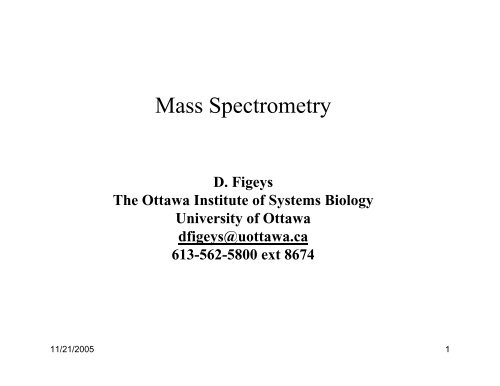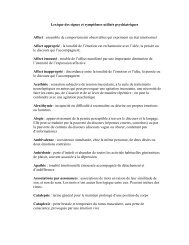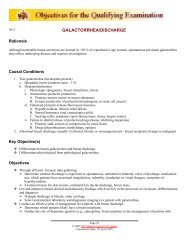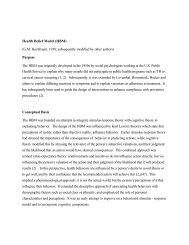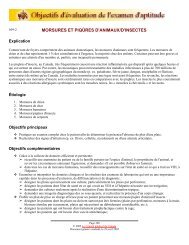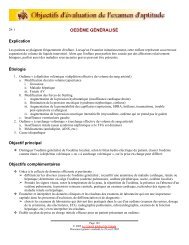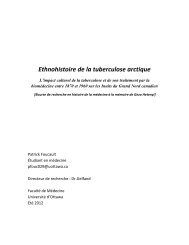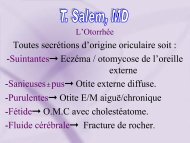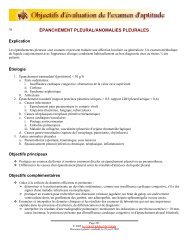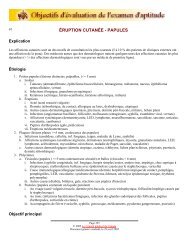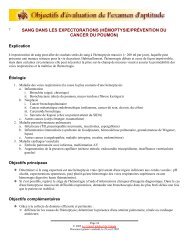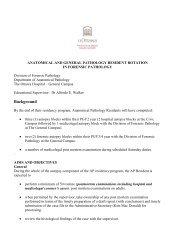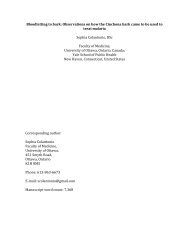Mass Spectrometry - Faculté de médecine de l'université d'Ottawa
Mass Spectrometry - Faculté de médecine de l'université d'Ottawa
Mass Spectrometry - Faculté de médecine de l'université d'Ottawa
You also want an ePaper? Increase the reach of your titles
YUMPU automatically turns print PDFs into web optimized ePapers that Google loves.
<strong>Mass</strong> <strong>Spectrometry</strong><br />
D. Figeys<br />
The Ottawa Institute of Systems Biology<br />
University of Ottawa<br />
dfigeys@uottawa.ca<br />
613-562 613 562-5800 5800 ext 8674<br />
11/21/2005 1
11/21/2005 2
A mass spectrum: a plot of the relative abundance of ions of different m/z in a given sample.<br />
11/21/2005 3
Pumping<br />
system<br />
Sample<br />
introduction<br />
DIRECT<br />
INTRODUCTION<br />
(solid, liquid, gas)<br />
SEPARATION<br />
TECHNIQUES<br />
(HPLC, CE, GC)<br />
ION SOURCE<br />
(“ion ion generation”)<br />
generation<br />
EI, FAB,<br />
MALDI,Electrospray<br />
TOF, quadrupole, quadrupole,<br />
ion trap<br />
vacuum<br />
ANALYZER<br />
(“mass mass analysis”) analysis<br />
Detector<br />
Data<br />
Processing<br />
Brancia FL , Trieste, 12/02/2004<br />
11/21/2005 4
Pumping<br />
system<br />
Sample<br />
introduction<br />
DIRECT<br />
INTRODUCTION<br />
(solid, liquid, gas)<br />
SEPARATION<br />
TECHNIQUES<br />
(HPLC, CE, GC)<br />
ION SOURCE<br />
(“ion ion generation”)<br />
generation<br />
EI, FAB,<br />
MALDI,Electrospray<br />
TOF, quadrupole, quadrupole,<br />
ion trap<br />
vacuum<br />
ANALYZER<br />
(“mass mass analysis”) analysis<br />
Detector<br />
Data<br />
Processing<br />
Brancia FL , Trieste, 12/02/2004<br />
11/21/2005 5
The Turbomolecular pump:<br />
11/21/2005 6
Why is a vacuum necessary?<br />
The mean free path, λ, is the average distance traveled by an ion before it colli<strong>de</strong>s with an<br />
air molecule, and is given by:<br />
1<br />
λ = (1.4)<br />
Nσ<br />
where N is the gas number <strong>de</strong>nsity, and σ is the collision cross section between the ion<br />
and the molecule (typically ~50 Å 2 for a small pepti<strong>de</strong> ion). Using a collision cross<br />
section of 50 Å 2 , the following table may be constructed:<br />
11/21/2005 7
Pumping<br />
system<br />
Sample<br />
introduction<br />
DIRECT<br />
INTRODUCTION<br />
(solid, liquid, gas)<br />
SEPARATION<br />
TECHNIQUES<br />
(HPLC, CE, GC)<br />
ION SOURCE<br />
(“ion ion generation”)<br />
generation<br />
EI, FAB,<br />
MALDI,Electrospray<br />
TOF, quadrupole, quadrupole,<br />
ion trap<br />
vacuum<br />
ANALYZER<br />
(“mass mass analysis”) analysis<br />
Detector<br />
Data<br />
Processing<br />
Brancia FL , Trieste, 12/02/2004<br />
11/21/2005 8
Various ionisation<br />
methods<br />
�� Electron impact ionisation (1919 A.J.<br />
Dempster)<br />
Dempster<br />
�� Chemical Ionisation CI<br />
�� Fast atomic bombardment FAB (1981 M.<br />
Barber)<br />
�� Matrix-assisted Matrix assisted laser <strong>de</strong>sorption<br />
ionisation MALDI (1988 K. Tanaka, M.<br />
Karas F. Hillenkamp)<br />
Hillenkamp<br />
�� Electrospray ES (1985, J. Fenn) Fenn<br />
Brancia FL, Trieste, 12/02/2004<br />
11/21/2005 9
1. Gas phase ion production:<br />
Solid Liquid Gas<br />
Ice Water Steam<br />
Protein<br />
Charred Protein<br />
Soft ionization techniques:<br />
1. Electrospray ionization (ESI)<br />
2. Matrix-assisted laser<br />
<strong>de</strong>sorption ionization (MALDI)<br />
11/21/2005 10
Electrospray ionization<br />
11/21/2005 11
Credited with the invention<br />
of electrospray ionization<br />
(ESI)<br />
11/21/2005 12
Droplet shrinks<br />
due to solvent<br />
evaporation<br />
electrospray<br />
capillary<br />
Droplet explo<strong>de</strong>s due<br />
to charge <strong>de</strong>nsity limit<br />
counter<br />
electro<strong>de</strong><br />
(near ground)<br />
skimmer<br />
electro<strong>de</strong>s<br />
atmospheric<br />
pressure<br />
mass analyzer<br />
[M+nH] M+nH] n+<br />
Gaseous ions formed via<br />
one of two proposed<br />
mechanisms<br />
high vacuum<br />
pressure gradient<br />
potential gradient<br />
+HV<br />
Brancia FL, Trieste, 12/02/2004<br />
11/21/2005 sample<br />
11/21/2005<br />
13<br />
solution
ESI<br />
solution<br />
Spray capillary – 2-5 kV Taylor<br />
cone<br />
-<br />
+<br />
+ + +<br />
+ + + + + + + +<br />
- -<br />
+<br />
-<br />
- -<br />
- - -<br />
- - -<br />
Electron<br />
flow<br />
Oxidation<br />
+ +<br />
+<br />
+ +<br />
+ +<br />
+ +<br />
+<br />
-<br />
Excess charge<br />
on surface<br />
+ -<br />
Power supply<br />
2-5 kV<br />
ESI droplets<br />
++<br />
+<br />
+ +<br />
+ +-<br />
++ + +<br />
+ +-<br />
++ + +<br />
+ +-<br />
+<br />
+<br />
Metal<br />
plate<br />
0-1 kV<br />
+ +<br />
+ + +<br />
+ +<br />
+ + + + +<br />
+ + + +<br />
+<br />
+ + + ++ +<br />
+ +<br />
Solvent and<br />
neutralized ions<br />
<strong>Mass</strong><br />
spectrometer<br />
Reduction<br />
Electrospray ionization. An analyte solution is sprayed through a charged capillary towards the<br />
sampling orifice of the mass spectrometer; individual ions are sampled by the mass spectrometer in the<br />
gas-phase.<br />
11/21/2005 14
Two examples of common ESI oxidation reactions are:<br />
and<br />
4OH - (aq) � O2(g) + 2H2O(l) + 4e - (aq) (1.1)<br />
E o (reduction) = 0.40 V<br />
2H2O(l) � O2(g) + 4H + (aq) + 4e - (aq) (1.2)<br />
E o (reduction) = 1.23 V<br />
The majority of electrosprayed positive ions impinge on the surface of the plate and are<br />
neutralized or reduced. Electrospray capillaries are composed of materials that have<br />
higher reduction potentials (or ionization energies) than that of OH - or H2O so that the<br />
appearance of metal ions in the mass spectra is avoi<strong>de</strong>d 11 , for example:<br />
M(s) � M + (aq) + e - (aq) (where M is a <strong>de</strong>fined material) (1.3)<br />
Generally these inclu<strong>de</strong>, platinum (E o (reduction) = 1.2 V 13 ), palladium (E o (reduction) = 0.987<br />
V 14 ), gold (E o (reduction) = 1.68 V 13 ), stainless steel (mixture of Mn and Cr oxi<strong>de</strong>s<br />
(E o (reduction) is between 1.2 and 1.5 V 13 ) and fused silica (SiO2) (non-conductive) mixed<br />
with stainless steel components.<br />
11/21/2005 15
ESI<br />
solution<br />
-<br />
2-5 kV<br />
+<br />
+ + +<br />
+ + + + + + + +<br />
- -<br />
+<br />
-<br />
- -<br />
- - -<br />
- - -<br />
+ +<br />
+ + + +<br />
+<br />
+<br />
+<br />
+<br />
+ + + + +<br />
+ a)<br />
+<br />
+ + +<br />
++<br />
++ ++ ++ ++ ++<br />
Uneven Rayleigh fission<br />
b)<br />
c) +<br />
+<br />
+ +<br />
+<br />
+ +<br />
+ +<br />
+ +<br />
+<br />
-<br />
Highly charged droplets<br />
Radii = 10-20 nm<br />
ESI droplets<br />
++<br />
+<br />
+ +<br />
+ +-<br />
++ + +<br />
+ +-<br />
++ + +<br />
+ +-<br />
+<br />
+<br />
0-1 kV<br />
+ +<br />
+ + +<br />
+ +<br />
+ + + + +<br />
+ + + +<br />
+<br />
+ + + ++ +<br />
+ +<br />
<strong>Mass</strong><br />
spectrometer<br />
ESI process revealing droplet shrinkage and a) uneven Rayleigh fission, followed by two divergent ion<br />
11/21/2005 <strong>de</strong>solvation theories: b) the ion evaporation theory 16<br />
17, 18 , and c) the charge residue theory5 .<br />
+ + +<br />
+<br />
+<br />
+<br />
Single solvated ions<br />
Radii = 1-10 µm<br />
Solvated clusters ejected<br />
Complete solvent evaporation<br />
produces bare ions
The principal outcome of the electrospray<br />
process is the transfer of analyte species,<br />
generally ionised in con<strong>de</strong>nsed phase, into<br />
the gas phase as isolated entities<br />
+HV<br />
+ + + + + + + +<br />
+ ++ + ++<br />
+ Aerosol of<br />
charged droplets<br />
Gaskell SJ Jounal of <strong>Mass</strong> <strong>Spectrometry</strong> 1997 Brancia FL, Trieste, 12/02/2004<br />
11/21/2005 17
11/21/2005 18
ESI<br />
+<br />
+<br />
+<br />
+<br />
+<br />
Direction of<br />
electric field<br />
+ Analyte ion<br />
760 Torr<br />
+<br />
+<br />
CP<br />
Adducted solvent molecule<br />
55 psi 2.5 Torr 10 -3 Torr<br />
N 2<br />
+ + +<br />
N 2<br />
CUR RNG<br />
OR SK<br />
The front end of a mass spectrometer <strong>de</strong>signed to sample ions produced by ESI.<br />
11/21/2005 19<br />
q0<br />
IQ1
4 - 5.5 kV<br />
ESI<br />
solution<br />
-<br />
+<br />
+ + +<br />
+ + + + + + + +<br />
- -<br />
+<br />
-<br />
- -<br />
- - -<br />
- - -<br />
Flow of gas (N 2 or air) nebulizing<br />
the solution being electrosprayed<br />
+ +<br />
+<br />
+ +<br />
+ +<br />
+ +<br />
+<br />
-<br />
ESI droplets<br />
++<br />
+<br />
+ +<br />
+ +-<br />
++ + +<br />
+ +-<br />
++ + +<br />
+ +-<br />
+<br />
+<br />
0 - 1 kV<br />
+ +<br />
+ + +<br />
+ +<br />
+ + + + +<br />
+ + + +<br />
+<br />
+ + + ++ +<br />
+ +<br />
<strong>Mass</strong><br />
spectrometer<br />
Schematic diagram of ionspray, or pneumatically-assisted electrospray ionization. The Taylor cone is<br />
nebulized with N2 or air, aiding droplet formation and <strong>de</strong>solvation and allowing for a more stable spray<br />
and higher flow rates.<br />
11/21/2005 20
ES spectrum of Rho protein<br />
100<br />
%<br />
682.1<br />
682.0<br />
672.4<br />
672.2<br />
653.9<br />
724.1<br />
713.2<br />
713.0<br />
702.6<br />
702.4<br />
735.5<br />
759.3<br />
771.6<br />
759.1<br />
747.1<br />
784.4<br />
797.7<br />
825.6<br />
840.3<br />
855.6<br />
871.7<br />
888.0<br />
Rho Protein: 47004.33 Da<br />
905.0<br />
941.0<br />
[M+56H] 56+<br />
960.2 980.3<br />
0<br />
m/z<br />
600 650 700 750 800 850 900 950 1000 1050 1100 1150 1200 1250 1300<br />
11/21/2005 Openshaw Brancia FL, Trieste, 12/02/2004<br />
21<br />
1001.2<br />
Courtesy of Dr Matt Openshaw<br />
[M+50H] 50+
Electrospray (ES)<br />
[M+56H] 56+ = 840.3 m/z<br />
Therefore, M = [840.3 x 56] – 56<br />
= 47000.8 Da<br />
Deconvolution: Takes all the multiply charged<br />
ions and converts them into a spectrum on a<br />
mass (Da) scale i.e. works out the molecular<br />
weight is most likely to be.<br />
Brancia FL, Trieste, 12/02/2004<br />
11/21/2005 22
100<br />
%<br />
ES spectrum after<br />
<strong>de</strong>convolution<br />
47004.9<br />
47004.0 Da<br />
0<br />
mass<br />
44000 44500 45000 45500 46000 46500 47000 47500 48000 48500 49000 49500 50000<br />
Brancia FL, Trieste, 12/02/2004<br />
11/21/2005 23
Relative abundance<br />
A) <strong>Mass</strong> spectrum of unfol<strong>de</strong>d cytochrome c leading to higher charge states from a higher <strong>de</strong>gree of<br />
protonation (most abundant charge state has 16 positive charges on it). B) <strong>Mass</strong> spectrum of cytochrome<br />
c in a more native, fol<strong>de</strong>d conformation resulting in less protonation (8 or 9 positive charges on it).<br />
(Adapted from Konermann, L., Collings, B.A., Douglas, D.J. Cytochrome c folding kinetics studied by timeresolved<br />
electrospray ionization mass spectrometry. Biochemistry 36, 5554-5559 (1997)).<br />
11/21/2005 24<br />
Relative abundance
22+<br />
11/21/2005 25<br />
22+
Advantages<br />
�� Production of molecular ions from solution<br />
�� The ease of coupling with separation<br />
techniques (micro LC-MS/MSMS,<br />
LC MS/MSMS, nano LC- LC<br />
MS/MSMS)<br />
�� Production of multiply charged ions<br />
Brancia FL, Trieste, 12/02/2004<br />
11/21/2005 26
Matrix assisted laser <strong>de</strong>sorption<br />
ionization<br />
11/21/2005 27
Credited with the invention<br />
of laser <strong>de</strong>sorption ionization<br />
(LDI) which led to the<br />
<strong>de</strong>velopment of MALDI<br />
11/21/2005 28
A standard 100 well UV MALDI sample plate.<br />
11/21/2005 29
2,5-Dihydroxy<br />
benzoic acid<br />
(DHB)<br />
Trans-3,5-dimethoxy-4-hydroxy<br />
cinnamic acid (commonly<br />
known as sinapic acid or<br />
Sinapinic acid, SA)<br />
4-Hydroxy-α-cyanocinnamic acid Glycerol*<br />
* - common matrix for IR MALDI experiments<br />
2,4,6-Trihydroxy<br />
acetophenone<br />
(THAP)<br />
Common chromophoric matrices used in UV MALDI with the noted exception of glycerol (in grey box),<br />
which is commonly used as a chromophoric matrix in IR MALDI.<br />
11/21/2005 30
Sample plate<br />
2-3 kV<br />
+<br />
+<br />
+<br />
+<br />
+<br />
+<br />
+<br />
+<br />
+<br />
+<br />
+<br />
+<br />
+<br />
+<br />
+<br />
+<br />
+<br />
+<br />
+<br />
+<br />
+<br />
++<br />
+<br />
+<br />
+<br />
N 2 laser<br />
(337 nm)<br />
+<br />
+<br />
+<br />
Grid or lens<br />
at lower<br />
voltage than<br />
plate<br />
+<br />
+<br />
+<br />
++<br />
+<br />
Vi<strong>de</strong>o<br />
camera<br />
The matrix-assisted laser <strong>de</strong>sorption ionization process. Laser ablation causes ions and neutrals to be<br />
<strong>de</strong>sorbed and efficient ionization to occur. Ions are released into the gas-phase and their m/z ratios analyzed<br />
11/21/2005 31<br />
by mass spectrometry.<br />
Ions<br />
Ions<br />
Ions<br />
Ions<br />
Ions<br />
+<br />
+<br />
Neutral matrix<br />
+<br />
1 + matrix<br />
1 + matrix dimer<br />
+<br />
+<br />
+ +<br />
++<br />
+<br />
+<br />
+<br />
+<br />
+<br />
Neutral analyte<br />
1 + analyte<br />
+<br />
1 + analyte dimer<br />
++ 2+ analyte
MALDI is an efficient <strong>de</strong>sorption<br />
ionisation technique for producing<br />
gaseous ions from a solid sample<br />
by laser pulses<br />
[M+H] +<br />
Brancia FL, Trieste, 12/02/2004<br />
11/21/2005 32
Why is the matrix so<br />
important?<br />
�� Matrix is necessary to dilute and disperse<br />
the analyte<br />
�� It functions as energy mediator for<br />
ionising the analyte itself or other neutral<br />
molecule<br />
�� It forms an activated state produced by<br />
photo ionisation<br />
Brancia FL, Trieste, 12/02/2004<br />
11/21/2005 33
Proposed MALDI mechanisms:<br />
1. Primary ionization mechanisms<br />
i. Multiphoton ionization<br />
ii. Energy pooling and multicenter mo<strong>de</strong>ls<br />
iii. Excited-state proton transfer (ESPT)<br />
iv. Disproportionation reactions<br />
v. Desorption of pre-formed ions<br />
vi. Thermal ionization<br />
2. Secondary ionization mechanisms<br />
i. Gas-phase proton transfer<br />
ii. Gas-phase cationization<br />
iii. Electron transfer<br />
MALDI is likely a combination of many of these<br />
11/21/2005 34
Matrix Assisted Laser<br />
Desorption/Ionisation<br />
(MALDI)<br />
Unlike ES, MALDI forms predominantly singly<br />
charged ions e.g. [M+H] + or adducts (sodium<br />
[M+Na] + or potassium [M+K] + )<br />
[M+H] +<br />
22 m/z<br />
Sodium = 23 amu<br />
Potassium = 39 amu<br />
[M+Na] +<br />
38 m/z<br />
[M+K] +<br />
Brancia FL, Trieste, 12/02/2004<br />
11/21/2005 35
Advantages<br />
�� MALDI primarily creates singly charged<br />
ions [M+H] +<br />
�� Less sensitive to contaminants<br />
�� Sensitivity at femtomole level<br />
�� High throughput analysis<br />
Brancia FL, Trieste, 12/02/2004<br />
11/21/2005 36
Pumping<br />
system<br />
Sample<br />
introduction<br />
DIRECT<br />
INTRODUCTION<br />
(solid, liquid, gas)<br />
SEPARATION<br />
TECHNIQUES<br />
(HPLC, CE, GC)<br />
ION SOURCE<br />
(“ion ion generation”)<br />
generation<br />
EI, FAB,<br />
MALDI,Electrospray<br />
TOF, quadrupole, quadrupole,<br />
ion trap<br />
vacuum<br />
ANALYZER<br />
(“mass mass analysis”) analysis<br />
Detector<br />
Data<br />
Processing<br />
Brancia FL , Trieste, 12/02/2004<br />
11/21/2005 37
Quadrupole<br />
11/21/2005 38
-(U + V o cosΩt)<br />
r<br />
r o<br />
+<br />
−<br />
−<br />
+<br />
(U + V o cosΩt)<br />
r = 1.1487r o<br />
Schematic of a quadrupole mass filter. Rods opposite from each other carry the same direct current (DC or<br />
U) potential and RF (V) potential. Rods in the x-direction carry a positive U; rods in the y-direction carry a<br />
negative U and an RF potential that is 180<br />
11/21/2005 39<br />
o out of phase from the RF potential applied to the rods in the xdirection.<br />
Ions enter the rods and travel in the z-direction stabilized by the quadrupolar electric field set up in<br />
the x-y plane. In or<strong>de</strong>r to optimize the field to maximize ion transmission and filtration efficacy, the rods have<br />
a radius (r) that is 1.1487 times as large as the distance of closest approach from one of them to the central<br />
z-axis of the ensemble (ro ).<br />
y<br />
x<br />
z
100<br />
RF potential<br />
-100<br />
+100<br />
-100<br />
-100<br />
+100<br />
-100<br />
y<br />
z<br />
+100<br />
+100<br />
x<br />
-100<br />
The hypothetical voltages on a quadrupole operating in RF-only mo<strong>de</strong> versus time (t). The quadrupoles are<br />
displayed with the x-y plane perpendicular to the page (z-direction going into the page). The two rods in the yz<br />
direction operate with an RF potential that is 180<br />
11/21/2005 40<br />
o out of phase from the rods in the x-z direction.<br />
+100<br />
-100<br />
-100<br />
+100<br />
t
http://elchem.kaist.ac.kr/vt/chem-ed/ms/quadrupo.htm<br />
Ramping magnitu<strong>de</strong> of the DC/AC in a constant ratio<br />
produces a mass spectrum!<br />
11/21/2005 41
Single quadrupole<br />
The quadrupole mass analyzer can separate ions according to their m/z ratio<br />
11/21/2005 42
What if we place three quadrupoles in a row?<br />
Q1 Q2 Q3<br />
What if we place the second quadrupole can be<br />
used to break molecules?<br />
gas<br />
11/21/2005 43
MS<br />
MS scan<br />
11/21/2005 44
Product ion scan or MS/MS<br />
MS/MS gas<br />
Product ion scan: Q1 allows 1 type of ion through, it fragments in q2,<br />
and Q3 ramps and analyzes the products.<br />
11/21/2005 45
MS<br />
Precurson ion scan<br />
gas<br />
Q1 ramps and analyzes each ion, they fragment in q2,<br />
and Q3 analyzes for one specific ion, when it is <strong>de</strong>tected, the spectrum<br />
displays the m/z of the ion that the fragment came from (the precursor ion).<br />
11/21/2005 46
MS<br />
Neutral loss scan<br />
gas<br />
Neutral loss scan: Q1 ramps and analyzes each ion, they fragment in q2,<br />
and Q3 ramps and analyzes each ion at the same rate, but out of phase with<br />
Q1, the spectrum displays the m/z of the ion that lost a specific mass so that it<br />
could pass through Q3 as well (neutral loss, since charge does not change).<br />
11/21/2005 47
Time of Flight<br />
11/21/2005 48
Time-of Time of-flight flight (ToF) mass<br />
MALDI target<br />
mv 2 /2= zV<br />
spectrometer<br />
Flight tube (field-free (field free region)<br />
Extraction grid<br />
t = 0 t = > 0<br />
Detector<br />
t2 =m/z(d 2 /2V)<br />
Brancia FL, Trieste, 12/02/2004<br />
11/21/2005 49
L<br />
H<br />
Ion<br />
accelerator<br />
L L L<br />
H H H<br />
Drift tube Ion<br />
<strong>de</strong>tector<br />
R = m/∆m<br />
= FWHM<br />
11/21/2005 50
Reflectron ion optics:<br />
s3<br />
s2<br />
s1<br />
700 V 0 V<br />
Ion<br />
<strong>de</strong>tector<br />
Ion<br />
accelerator<br />
Drift tube<br />
FOCAL POINT<br />
Ion<br />
mirror<br />
grid<br />
Ion mirror<br />
0 V 850 V<br />
Three different ions with i<strong>de</strong>ntical m/z ratios<br />
11/21/2005 51
Sample plate<br />
Turbomolecular<br />
pump<br />
Ionization<br />
Pulsing region<br />
laser<br />
Separation<br />
camera<br />
Detectors<br />
(reflectron mo<strong>de</strong>)<br />
Ion<br />
<strong>de</strong>flector<br />
Turbomolecular<br />
pump<br />
Detector<br />
(linear mo<strong>de</strong>)<br />
Ion mirror<br />
11/21/2005 52
Time-Of Time Of-Flight Flight MS<br />
11/21/2005 53
2000<br />
1500<br />
1000<br />
500<br />
0<br />
MALDI spectrum of an enolase tryptic<br />
digest<br />
656.16<br />
726.43<br />
R<br />
756<br />
R<br />
807.46<br />
1057.77<br />
1170.72 1159.77<br />
1286.90<br />
1308.83<br />
R<br />
1412.96<br />
11/21/2005 54<br />
R<br />
1790.0320<br />
1822.1611<br />
R<br />
R<br />
K<br />
K K<br />
184<br />
2442.40
Ion traps: Hyperbolic<br />
11/21/2005 55
Ion generation<br />
ESI<br />
Electrospray- Ion Trap mass spectrometer<br />
Ion Gui<strong>de</strong> Ion trap Detector<br />
11/21/2005 56
Ion Trap.<br />
Axial<br />
Radial<br />
toroidal ring electro<strong>de</strong><br />
two hyperbolic endcap electro<strong>de</strong>s.<br />
11/21/2005 57<br />
RF<br />
DC<br />
=0V
Ion injection, and gating<br />
Time<br />
Ion injection<br />
Ion gating<br />
11/21/2005 58
Once in the trap<br />
11/21/2005 59
11/21/2005 60
Ion traps: Linear<br />
11/21/2005 61
Linear ion trap<br />
11/21/2005 62
Ion traps: Orbital<br />
11/21/2005 63
Trajectories in the orbitrap<br />
�� Characteristic frequencies:<br />
Characteristic frequencies:<br />
�� Frequency of rotation<br />
Frequency of rotation ωω φφ<br />
�� Frequency of radial oscillations<br />
�� Frequency of axial oscillations<br />
r<br />
Frequency of radial oscillations ωω rr<br />
Frequency of axial oscillations ωω zz<br />
φ<br />
2 2 2<br />
{ z − r / 2 + R ln( r / R ) }<br />
k<br />
U ( r,<br />
z)<br />
= ⋅<br />
m ⋅<br />
2<br />
ω = ω<br />
11/21/2005 64<br />
m<br />
z<br />
ω ϕ<br />
ω<br />
r<br />
z<br />
=<br />
=<br />
ωz<br />
2<br />
z<br />
⎛<br />
⎜<br />
⎝<br />
⎛<br />
⎜<br />
⎝<br />
Rm R<br />
k<br />
m / q<br />
Rm R<br />
⎞<br />
⎟<br />
⎠<br />
2<br />
⎞<br />
⎟<br />
⎠<br />
2<br />
−1<br />
− 2
Lord of the ion rings: Forging of<br />
the ring<br />
Electrodynamic<br />
Squeezing<br />
A.A. Makarov, Anal. Chem., v.72<br />
(2000), No.6, p.1156-1162.<br />
A.A. Makarov, US Pat. 5,886,346,<br />
1999.<br />
“Fast” Injection
Lord of the ion rings:<br />
Retainment of the rings<br />
ω =<br />
1. Frequencies are <strong>de</strong>termined using a Fourier Transformation<br />
2. For higher sensitivity AND resolution, transients should not <strong>de</strong>cay too fast<br />
Ultra-high vacuum Ultra-high precision<br />
11/21/2005 66<br />
k<br />
m /<br />
z
LTQ-Orbitrap: LTQ Orbitrap: 2 nd generation of the<br />
“fast fast” injection (orthogonal)<br />
1. Ions are stored in the linear trap<br />
2. …are axially ejected<br />
3. …and trapped in the C-trap and<br />
squeezed into a smaller cloud<br />
4. …then a voltage pulse across C-trap<br />
ejects ions towards the Orbitrap<br />
5. …where they are trapped and <strong>de</strong>tected<br />
-2 k V<br />
-3.5 k V<br />
Central<br />
Electro<strong>de</strong><br />
Voltage<br />
11/21/2005 67<br />
V<br />
Gas
Hybrid: Qq-TOF Qq TOF<br />
11/21/2005 68
700 L/s<br />
250 L/s<br />
Ion<br />
path Q<br />
760<br />
Torr<br />
55<br />
psi<br />
2.5<br />
Torr<br />
10 -3 Torr<br />
Ion Gauge<br />
3 x 10 -5 Torr<br />
Schematic of a QqTOF mass spectrometer<br />
indicating the pressures of the various inner<br />
chambers (in red). Both of the analyzer chambers<br />
are equipped with ion gauges, which accurately<br />
measure the pressure in these regions. On the<br />
si<strong>de</strong>s of the instrument (in grey) are 3<br />
turbomolecular pumps, two with pumping speeds<br />
of 700 L/s, and one with a pumping speed of 250<br />
L/s.<br />
700 L/s<br />
Ion Gauge<br />
3 x 10 -7 Torr<br />
11/21/2005 69<br />
q<br />
TOF
q0 ST<br />
IQ1 GR<br />
Q1<br />
Schematic of a QqTOF mass spectrometer revealing the positions of the quadrupoles (q0, ST, Q1, and q2).<br />
Lowercase “q” refers to a non-resolving quadrupole while uppercase “Q” indicates that the quadrupole has<br />
resolving capabilities; “ST” refers to the stubby quadrupole. IQ1, IQ2, and IQ3 refer to the inter-quadrupole<br />
(IQ) lenses and GR refers to the grid (consi<strong>de</strong>red a part of the TOF region, vi<strong>de</strong> infra). The orange dotted line<br />
11/21/2005 represents the ion path traveling axially, or in the z-direction of the instrument.<br />
70<br />
q2<br />
IQ2 IQ3
11/21/2005 71
700 L/s<br />
Q3 can be replaced by a<br />
time-of-flight (TOF)<br />
mass analyzer<br />
250 L/s<br />
Ion<br />
path Q<br />
760<br />
Torr<br />
55<br />
psi<br />
2.5<br />
Torr<br />
10 -3 Torr<br />
Ion Gauge<br />
Q1 q2<br />
Q3<br />
3 x 10 -5 Torr<br />
700 L/s<br />
Ion Gauge<br />
3 x 10 -7 Torr<br />
11/21/2005 72<br />
q<br />
TOF
GR<br />
q0<br />
SL Pusher<br />
Q1<br />
Puller<br />
q2<br />
TOF<br />
Liner<br />
Ion mirror<br />
Detector<br />
(MCP)<br />
11/21/2005 73
Time-of-flight (TOF)<br />
mass spectrometry:<br />
zeEs = 1/2mv 2<br />
v = ((2zeEs)/m) 1/2<br />
11/21/2005 74
Fourier transformed ion<br />
cyclotron<br />
11/21/2005 75
Animation<br />
11/21/2005 76
Protein i<strong>de</strong>ntification by mass<br />
spectrometry.<br />
11/21/2005 77
Protein i<strong>de</strong>ntification by mass spectrometry<br />
MS<br />
MALDI-TOF<br />
<strong>Mass</strong> of pepti<strong>de</strong>s<br />
From proteins<br />
MS+ MS/MS<br />
Triple quadrupole<br />
Ion trap, Qstar, Qtof<br />
O-maldi, FT-MS<br />
<strong>Mass</strong> of pepti<strong>de</strong>s<br />
And fragmentation patterns<br />
Related to their amino acid sequence<br />
11/21/2005 78
Protein i<strong>de</strong>ntification: Bioinformatic<br />
Basic principle: Proteins are i<strong>de</strong>ntified by correlating the<br />
information obtained from the mass spectrometer and the<br />
information contained in protein and/or DNA sequence databases.<br />
The result is a link between a protein on a 2D gel and a<br />
corresponding protein and/or DNA sequence entry in a database.<br />
U. Washington and Finnigan: Sequest<br />
EMBL: Sequence TAG<br />
Protein prospector: MS-FIT, MS-TAG, MS-Products<br />
Rockefeller and Proteometrix: ProFound<br />
Mascot<br />
11/21/2005 79
Pepti<strong>de</strong> mass fingerprinting<br />
11/21/2005 80
MALDI-TOF spectrum<br />
11/21/2005 81
Pepti<strong>de</strong> mass fingerprinting: principle<br />
MS<br />
600 Da<br />
840 Da<br />
1044 Da<br />
1236 Da<br />
1650 Da<br />
Trypsin<br />
Database:<br />
MKALSPVRGCYEAVCCLSERSLAIARGRGKSPSA<br />
EEPLSLLDDMNHCYSRLRELVPGVPRGTQLSQVEI<br />
LQRVIDYILDLQVVLAEPAPGPPDGPHLPIQVREGA<br />
RPGSSERAGWDAAGLPHRVLEYLG<br />
AVAKVELRGTVQPASNFNDDGDAQGLGTDEGAIIX<br />
VLTQRSNAQAVEGAGTDESTLIELMATRNNQEIAAI<br />
NEAYSLEDDLSSDTSGHFRILVSLALGNRDEGPEN<br />
LTQAVVAETLNKPAFFADRLLALXGGDD<br />
MRWLTPFGMLFISGTYYGLIFFGLIMEVIHNALISLV<br />
LAFFVVFAWDLVLSLIYGLRFVKEGDYIALDWDGQ<br />
FPDCYGLFASTCLSAVIWTYTDSLLLGLIVPVIIVFL<br />
GKQLMRGLYEKIKS<br />
11/21/2005 82
Proteomic applications of mass spectrometry:<br />
AGAATVKENSSTRVKHCAAGAAWKAGGARERAAKTVAAKATVGGGRV<br />
MS<br />
Sequence MW<br />
• AGAATVK 617.3623<br />
• ENSSTR 693.3168<br />
•VK 246.1818<br />
• HCAAGAAWK 914.4307<br />
• AGGAR 431.2367<br />
•ER 304.1621<br />
• AAK 289.1876<br />
• TVAAK 489.3037<br />
• ATVGGGR 617.3371<br />
MW: 4551<br />
11/21/2005 83
MALDI-TOF: pepti<strong>de</strong> mass fingerprinting<br />
<strong>Mass</strong> 1<br />
<strong>Mass</strong> 2<br />
<strong>Mass</strong> 3<br />
<strong>Mass</strong> 4<br />
Nucleoti<strong>de</strong> or Protein<br />
Database<br />
>143B_BOVIN 14-3-3 PROTEIN BETA<br />
...<br />
MDKSELVQKAKLAEQAERYDDMAAM<br />
KAVTEQGHELSNEERNLLSVAYKNYG<br />
ARRSSWRVISSIEQKTERNEKKQQMG<br />
KEYREKIEAELQDICNVLQLLDK ...<br />
1 9.58 4/6 (66%) 4 3 HOMO SAPIENS 1308066 W28118 42c2 Human retina c<br />
randomly primed sublibrary<br />
sapiens cDNA.<br />
2 9.28 4/6 (66%) 4 6 HOMO SAPIENS 1308575 W28627 49d10 Human retina<br />
randomly primed sublibrary Ho<br />
sapiens cDNA.<br />
11/21/2005 84
Protein i<strong>de</strong>ntification by mass spectrometry<br />
tryptic digest<br />
500 1200 1900 2600 3300<br />
<strong>Mass</strong> (m/z)<br />
11/21/2005 85<br />
♦<br />
630.39 1022.48<br />
663.30<br />
1147.58<br />
♦<br />
♦<br />
internal calibration pepti<strong>de</strong><br />
1424.61<br />
♦<br />
1275.66<br />
1446.72<br />
♦<br />
2862.19<br />
2990.29
Tryptic pepti<strong>de</strong> fingerprint of MEF2C (TFP or PMF)<br />
630.39 1022.48<br />
663.30<br />
♦<br />
1147.58<br />
♦<br />
1275.66<br />
1424.61<br />
♦<br />
1446.73<br />
Pepti<strong>de</strong> Measured Calculated ∆<br />
(M+H) (M+H)<br />
6-10 630.388 630.39 0.002<br />
11-15 663.301 663.314 0.013<br />
80-89 1147.580 1147.596 0.016<br />
80-90 1275.659 1275.691 0.032<br />
120-130 1318.613 1318.668 0.055<br />
240-251 1327.613 1327.625 0.012<br />
69-79 1424.612 1424.608 0.004<br />
119-130 1446.728 1446.763 0.035<br />
92-118 2862.191 2862.176 0.015<br />
92-119 2990.294 2990.271 0.023<br />
2862.19<br />
2990.29<br />
500 1200 1900 2600 3300<br />
Ma s s (m/z)<br />
11/21/2005 ♦ internal calibration pepti<strong>de</strong><br />
86<br />
♦
MEF2A<br />
MGRKKIQITRIMDERNRQVTFTKRKFGLMKKAYELSVLCDCEIALIIFNSSNKLFQYA<br />
STDMDKVLLKYTEYNEPHESRTNSDIVEALNKKEHRGCDSPDPDTSYVLTPHTEEKY<br />
KKINEEFDNMMRNHKIAPGLPPQNFSMSVTVPVTSPNALSYTNPGSSLVSPSLAASST<br />
LTDSSMLSPPQTTLHRNVSPGAPQRPPSTGNAGGMLSTTDLTVPNGAGSSPVGNGFV<br />
NSRASPNLIGATGANSLGKVMPTKSPPPPGGGNLGMNSRKPDLRVVIPPSSKGMMPP<br />
LSEEEELELNTQRISSSQATQPLATPVVSVTTPSLPPQGLVYSAMPTAYNTDYSLTSAD<br />
LSALQGFNSPGMLSLGQVSAWQQHHLGQAALSSLVAGGQLSQGSNLSINTNQNISIK<br />
SEPISPPRDRMTPSGFQQQQQQQQQQQPPPPPQPQPQPPQPQPRQEMGRSPVDSLSSSS<br />
SSYDGSDREDPRGDFHSPIVLGRPPNTEDRESPSVKRMRMDAWVT<br />
The masses of these tryptic pepti<strong>de</strong>s that were<br />
observed in the mass spectrum<br />
11/21/2005 87
Why we can confi<strong>de</strong>ntly<br />
assign this protein as MEF2C<br />
# of matching pepti<strong>de</strong>s<br />
MEF2C 10<br />
(correct i<strong>de</strong>ntification)<br />
MEF2A 6<br />
(closely related protein)<br />
albumin 0<br />
(unrelated protein)<br />
11/21/2005 88
Database Searching<br />
WWW Sites:<br />
Matrix Science, http://www.matrixscience.com<br />
UCSF, http://prospector.ucsf.edu<br />
EMBL, http://www.mann.embl-hei<strong>de</strong>lberg.<strong>de</strong><br />
• continual updates<br />
• well maintained<br />
• free<br />
• similar searches<br />
11/21/2005 89
Tan<strong>de</strong>m mass spectrometry<br />
11/21/2005 90
AGAATVKENSSTRVKHCAAGAAWKAGGARERAAKTVAAKATVGGGRV<br />
MS<br />
Sequence MW<br />
• AGAATVK 617.3623<br />
• ENSSTR 693.3168<br />
•VK 246.1818<br />
• HCAAGAAWK 914.4307<br />
• AGGAR 431.2367<br />
•ER 304.1621<br />
• AAK 289.1876<br />
• TVAAK 489.3037<br />
• ATVGGGR 617.3371<br />
MS/MS<br />
MW: 4551<br />
147.11 y1 383.15 b3 483.21 a5<br />
603.33 y6 839.36 b8 284.12 a2<br />
404.23 y3 511.21 b5 625.29 a7<br />
848.41 y8 312.11 b2 426.19 a4<br />
532.29 y5 653.28 b7<br />
333.19 y2 454.19 b4<br />
554.25 a6 674.36 y7<br />
355.16 a3 475.27 y4<br />
582.25 b6 811.37 a8<br />
11/21/2005 91
A single pepti<strong>de</strong> can be selected with one MS<br />
and sequenced by a second MS<br />
630.39 1022.48<br />
663.30<br />
♦<br />
1147.58<br />
♦<br />
1275.66<br />
1424.61<br />
♦<br />
1446.72<br />
2862.19<br />
2990.29<br />
500 1200 1900 2600 3300<br />
11/21/2005 <strong>Mass</strong> (m/z)<br />
92<br />
♦
Select: TNSDIVETIR m n<br />
R m 1<br />
IR m 2<br />
TIR m 3<br />
ETIR m 4<br />
VETIR m 5<br />
NSDIVETLR m 9<br />
11/21/2005 93<br />
I<br />
T<br />
E<br />
V<br />
N
NH2<br />
CH<br />
R1<br />
x2 y2 z2 x1 y1 z1<br />
O<br />
C NH CH C NH CH C OH<br />
R2<br />
R3<br />
11/21/2005 94<br />
O<br />
a1 b1 c1 a2 b2 c2<br />
O
The pepti<strong>de</strong> fragments give us sequence<br />
I /<br />
information<br />
/ L<br />
11/21/2005 95
Tan<strong>de</strong>m mass spectrometry:<br />
<strong>de</strong> <strong>de</strong> novo novo sequencing<br />
11/21/2005 96
The 9 step strategy for manual interpretation of MS/MS spectra:<br />
1. Inspect the low-mass region for immonium ions<br />
2. Inspect the low-mass region for the b 2 -ion and a 2 -ion combo<br />
3. Inspect the low-mass region for the y 1 -ion<br />
4. Inspect the high-mass region for the y n-2 -ion, from this try to<br />
i<strong>de</strong>ntify the y n-1-ion<br />
5. Extend the y-ion series toward lower m/z<br />
6. Extend the b-ion series toward higher m/z<br />
7. Calculate the mass of the pepti<strong>de</strong><br />
8. Check that the amino acid content agrees with the immonium<br />
ions observed. Consi<strong>de</strong>r the charge state and whether there is an<br />
internal H, K, or R<br />
9. Attempt to i<strong>de</strong>ntify all ions in the spectrum<br />
11/21/2005 97
Back<br />
11/21/2005 98
The 9 step strategy for manual interpretation of MS/MS spectra:<br />
1. Inspect the low-mass region for immonium ions<br />
2. Inspect the low-mass region for the b 2 -ion and a 2 -ion combo<br />
3. Inspect the low-mass region for the y 1 -ion<br />
4. Inspect the high-mass region for the y n-2 -ion, from this try to<br />
i<strong>de</strong>ntify the y n-1-ion<br />
5. Extend the y-ion series toward lower m/z<br />
6. Extend the b-ion series toward higher m/z<br />
7. Calculate the mass of the pepti<strong>de</strong><br />
8. Check that the amino acid content agrees with the immonium<br />
ions observed. Consi<strong>de</strong>r the charge state and whether there is an<br />
internal H, K, or R<br />
9. Attempt to i<strong>de</strong>ntify all ions in the spectrum<br />
11/21/2005 99
400<br />
300<br />
200<br />
100<br />
0<br />
Step 1: Immonium ions<br />
m/z 86<br />
Imm of L/I<br />
100 200 300 400 500 600 700 800 900 1000 1100<br />
m/z<br />
11/21/2005 File: CID 612.8380(2+), Date: 11/09/2002 14:18<br />
100<br />
Resolution: 0.6 ns, Display bin: 115.0 ns, Starts: 6886
400<br />
300<br />
200<br />
100<br />
0<br />
Step 2: b 2 and a 2 -ions<br />
m/z 215<br />
b 2 of (D/V) or ((L/I)/T)<br />
-28 Da = a 2<br />
100 200 300 400 500 600 700 800 900 1000 1100<br />
m/z<br />
11/21/2005 File: CID 612.8380(2+), Date: 11/09/2002 14:18<br />
101<br />
Resolution: 0.6 ns, Display bin: 115.0 ns, Starts: 6886
400<br />
300<br />
200<br />
100<br />
0<br />
Step 3: y 1 -ion<br />
m/z 175 = y 1 of R<br />
100 200 300 400 500 600 700 800 900 1000 1100<br />
m/z<br />
11/21/2005 File: CID 612.8380(2+), Date: 11/09/2002 14:18<br />
102<br />
Resolution: 0.6 ns, Display bin: 115.0 ns, Starts: 6886
400<br />
300<br />
200<br />
100<br />
0<br />
Step 4: Find y n-2 and y n-1<br />
Difference b/w y n-2 and y n-1 ions is 101 Da<br />
�<strong>Mass</strong> of T, therefore N-term is I/L followed<br />
by T.<br />
100 200 300 400 500 600 700 800 900 1000 1100<br />
m/z<br />
11/21/2005 File: CID 612.8380(2+), Date: 11/09/2002 14:18<br />
103<br />
Resolution: 0.6 ns, Display bin: 115.0 ns, Starts: 6886<br />
y n-2<br />
y n-1
400<br />
300<br />
200<br />
100<br />
0<br />
-R<br />
Step 5: Find y-ion series<br />
-I/L<br />
-P<br />
-S<br />
-S<br />
-G<br />
100 200 300 400 500 600 700 800 900 1000 1100<br />
m/z<br />
11/21/2005 File: CID 612.8380(2+), Date: 11/09/2002 14:18<br />
104<br />
Resolution: 0.6 ns, Display bin: 115.0 ns, Starts: 6886<br />
-Y<br />
-G<br />
-S<br />
-S<br />
-T<br />
-I/L
400<br />
300<br />
200<br />
100<br />
0<br />
Step 6: Find b-ion series<br />
I/L,T<br />
+S<br />
+S<br />
+G<br />
100 200 300 400 500 600 700 800 900 1000 1100<br />
m/z<br />
11/21/2005 File: CID 612.8380(2+), Date: 11/09/2002 14:18<br />
105<br />
Resolution: 0.6 ns, Display bin: 115.0 ns, Starts: 6886<br />
+Y<br />
+G<br />
+S
Step 7: Total Sequence <strong>Mass</strong>: 1224 Da<br />
Estimated Sequence:<br />
I/L,T,S,S,G,Y,G,S,S,P,I/L,R<br />
Estimated Sequence mass:<br />
1224 Da!<br />
Step 8: We see I/L imm in the low mass region<br />
Step 9: Don’t have time now…<br />
11/21/2005 106
400<br />
300<br />
200<br />
100<br />
0<br />
Pepti<strong>de</strong> sequence:<br />
LTSSGYGSSPLR<br />
*<br />
y 1 , R H+<br />
b 2 , H+ LT<br />
*<br />
y 2 , LR H+<br />
b 4 , H+ LTSS<br />
y 3 , PLR H+<br />
b 3 , H+ LTS<br />
Precursor ion<br />
y 4 , SPLR H+<br />
b 5 , H+ LTSSG<br />
b 6 , H+ LTSSGY<br />
y 6 , GSSPLR H+<br />
y 5 , SSPLR H+<br />
b 7 , H+ LTSSGYG<br />
y 8 , GYGSSPLR H+<br />
y 10 , SSGYGSSPLR H+<br />
y7 , YGSSPLRH+ y9 , SGYGSSPLRH+ b 8 , H+ LTSSGYGS<br />
y 11 , TSSGYGSSPLR H+<br />
100 200 300 400 500 600<br />
m/z<br />
700 800 900 1000 1100<br />
11/21/2005 107
Tan<strong>de</strong>m mass spectrometry:<br />
Sequence tag<br />
11/21/2005 108
Relative Abundance<br />
100<br />
80<br />
60<br />
40<br />
20<br />
0<br />
E<br />
Fribrinopepti<strong>de</strong> A<br />
A<br />
X<br />
F<br />
D<br />
400 600 800 1000 1200 1400 1600<br />
m/z<br />
11/21/2005 109<br />
G<br />
YADSGEGDFLAEGGGVR<br />
E<br />
G S<br />
D
I<strong>de</strong>ntification of Proteins by MS/MS Spectra and Sequence tag<br />
80<br />
40<br />
Pepti<strong>de</strong> mass<br />
(<strong>Mass</strong> 1 ) GEG (<strong>Mass</strong> 2 )<br />
0<br />
400 600 800 1000 1200 1400 1600<br />
m/z<br />
11/21/2005 110<br />
G E<br />
G<br />
Nucleoti<strong>de</strong> or Protein<br />
Database<br />
>143B_BOVIN 14-3-3 PROTEIN BETA<br />
...<br />
MDKSELVQKAKLAEQAERYDDMAAM<br />
KAVTEQGHELSNEERNLLSVAYKNYG<br />
ARRSSWRVISSIEQKTERNEKKQQMG<br />
KEYREKIEAELQDICNVLQLLDK ...
Relative Intensity<br />
TOF Binary data from:“536_3_3+?cal”<br />
100<br />
700<br />
600<br />
500<br />
400<br />
300<br />
200<br />
100<br />
0<br />
201.1 201.1<br />
200 40<br />
0<br />
540.3<br />
Sequence Tag<br />
689.9<br />
814.4<br />
G<br />
600 80<br />
m/z0<br />
H<br />
VEADIAGHGQEVLIR<br />
11/21/2005 111<br />
1008.5<br />
1009.0 1195.7<br />
1000 120<br />
0<br />
140<br />
0<br />
160<br />
0<br />
200 400 600 800 1000 1200 1400 1600<br />
m/z, amu<br />
G<br />
A<br />
I<br />
7.87e2
Tan<strong>de</strong>m mass spectrometry:<br />
No interpretation<br />
11/21/2005 112
80<br />
40<br />
0<br />
I<strong>de</strong>ntification of Proteins by MS/MS Spectra and SEQUEST<br />
Pepti<strong>de</strong> 1<br />
Pepti<strong>de</strong> mass<br />
low mass ions<br />
400 600 800 1000 1200 1400 1600<br />
m/z<br />
Correlation Analysis<br />
by SEQUEST<br />
Theoretical <strong>Mass</strong><br />
Spectrum<br />
11/21/2005 113<br />
% RA<br />
Nucleoti<strong>de</strong> or Protein<br />
Database<br />
>143B_BOVIN 14-3-3 PROTEIN BETA<br />
...<br />
MDKSELVQKAKLAEQAERYDDMAAM<br />
KAVTEQGHELSNEERNLLSVAYKNYG<br />
ARRSSWRVISSIEQKTERNEKKQQMG<br />
KEYREKIEAELQDICNVLQLLDK ...<br />
m/z
Tan<strong>de</strong>m mass spectrometry:<br />
Sample introduction<br />
11/21/2005 114
A)<br />
B)<br />
C)<br />
∆p<br />
Sample introduction: nanospray<br />
∆p<br />
HV<br />
11/21/2005 115
opening of 1 µm<br />
Pd / Au layer<br />
Nanospray Probe<br />
contains 1-2 µL of sample<br />
11/21/2005 116
A)<br />
B)<br />
C)<br />
HPLC/<br />
autosampler<br />
Sample introduction: HPLC<br />
+ 1 kV<br />
11/21/2005 117
165 minute run<br />
2 hr gradient<br />
1 sec survey scan<br />
1 sec MS/MS scan<br />
1 sec MS/MS scan<br />
1 sec MS/MS scan<br />
1 sec MS/MS scan<br />
11/21/2005 118


